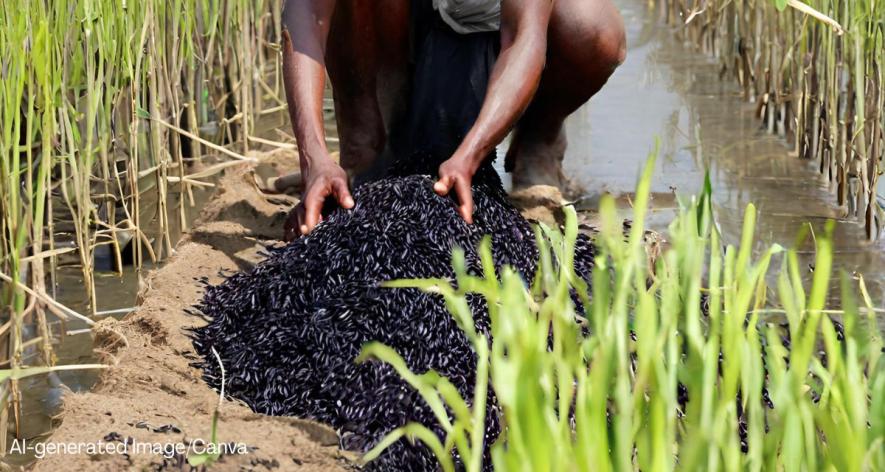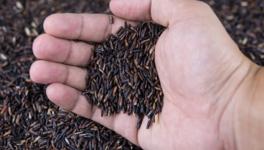Bihar's Black Rice Experiment Falters at First Step

Gaya, Bihar: Fed by River Brahmaputra, Assam’s Goalpara is known for its success with black rice. Upendra Rabha, a progressive farmer from Amguripara village, sowed the first seeds of change when he embarked on an experimental black rice cultivation in 2011.
Today, under the aegis of Assam Agribusiness and Rural Transformation Project (APART) run with the help of the World Bank, the state agricultural department strives to improve the financial status of tribals by making them take up black rice cultivation. As agricultural losses due to marauding elephant herds are very common here, the goal is to ensure good returns even from lesser yield/cultivated area.
With black rice wielding its power in the market with a selling rate of over Rs 100 per kg, it was hardly a surprise that this variety caught the fancy of a few farmers in Bihar. However, their attempts to rise above poverty by experimenting something new had an opposite effect.
Chandan Kumar (42) of Inguni in Gaya told 101Reporters that he got Chak-hao black rice seeds from Nagaland two years ago, after learning about it from his elder brother who works at Nagaland University's School of Agricultural Sciences and Rural Development.
Chandan’s relative and resident of Sondiha in Guraru block, Manoj Kumar (64) got black paddy seeds from him for Rs 220 per kg last year and launched the crop in one bigha. As Chandan had told that black rice can be sold for Rs 100 to 150 per kg, 15 farmers from Sondiha sowed this super grain last year in a total of over 10 acres. Another eight villages, including Paraiya and Dakhner, also saw its cultivation.
Kumar sowed four kg of black rice seeds on one bigha (0.62 acre) of land. At the time of replanting, around 30 kg diammonium phosphate was used, followed by 25 kg urea about a month later. What followed was quite a dampener.
“It was only later that we got to know that urea fertilizer should not have been given. Due to urea, the plant’s length increased and the paddy crop began to fall in the fields itself. All our hard work went in vain. I managed to get only six quintals of black rice from one bigha,” said Kumar.
But the biggest problem was yet to come. “We had a lot of difficulty finding a buyer. The market for this product is almost nil in Bihar,” said Kumar. When nothing worked, they decided to approach Chandan, who himself sold their paddy.
“Last year, I sold their paddy to a businessman from Chhattisgarh for Rs 45 per kg [4,500 per quintal]. This when common paddy was priced at Rs 1,600 to 1,700 per quintal in the market. This year, we again faced the same issue. The produce of some farmers was sent to Chennai at Rs 55 per kg,” Chandan said.
Despite the issues in market penetration and government support, farmers in Bihar are increasingly getting lured by the big money that black rice production can bring. Farmers in Gaya, Jehanabad, Aurangabad and Rohtas districts have been arranging expensive seeds of black rice with their own personal efforts.
“If the crop is good, we can easily get 12 quintals from one bigha,” Chandan reassured. “In neighbouring Jehanabad district, Patiyawan village mukhiya Rudreshwar Sharma is cultivating black rice on a large scale and also getting it done by other farmers,” he added.
However, those who have already made the plunge detest it. “We were given the dream that this paddy will bring good yield and income, but the opposite happened. Usually, 12 to 14 quintals per bigha of common rice [fetching a maximum of Rs 23,800] is produced here, but we got only six to seven quintals of black rice [maximum Rs 31,500]. We do not know what to do with this rice now. It is still lying unused in the houses of many farmers. We will think twice before cultivating it again,” Kumar said.
Why not Bihar?
Bihar government’s focus is on promoting new varieties of maize and baby corn, and old varieties of wheat. The government also lays more emphasis on horticulture. As much as 50 to 75% subsidy is given to farmers for planting figs, guava, lemongrass etc. So there has been no government efforts to help farmers who cultivate black rice. Some senior agriculture department officials told 101Reporters on condition of anonymity that no file regarding black rice has come up before them so far.
Dr Neelanjaya, Associate Professor, Genetics and Plant Breeding, and Principal Investigator (Rice), Dr Rajendra Prasad Central Agricultural University (RPCAU), Pusa, told 101Reporters that he has cultivated black rice for his university research work. "If Bihar government wants, we can immediately provide up to 60 kg of seeds to farmers from the university's seed farm. All that is needed is initiative,” he asserted.
Even Bihar's farmers are not aware of the benefits of black rice, which eventually prevents scaling up of production. According to the US Department of Agriculture, 100 gram of cooked black rice provides 356 kcal energy, 8.89 gram proteins, 3.33 gram total lipids (fats), 75.56 gram carbohydrates and 2.4 mg iron. In fact, black rice has the highest protein content among all rice varieties.
Black rice contains anthocyanins, a group of antioxidants, and vitamin E. It is also good for liver and kidney, and is recommended for diabetes patients due to its low glycemic index. It is rich in potassium, carotenoids, amino acids and fatty acids.
Black rice is good for making kheer (sweet rice pudding) and cakes. It is is also suitable for rice beer, which tastes better than the one made from white rice. The taste of black rice varies from region to region, but it always has a nutty flavour. Paddy expert Dr BN Singh, who retired as head of Genetics and Plant Breeding Department of RPCAU, said black rice does not cook fast like normal rice.
Citing the case of Chak-hao of Manipur that recently received Geographical Indications (GI) tag, Dr Singh pointed out that the recognition definitely aided in increasing exports from that region. This variety has been in cultivation in the northeastern state since the ancient times. On the other hand, black rice has come to Bihar only recently and is a new crop for the region. Obviously, it does not carry a GI tag.
Moreover, there is no pioneering farmer like Upendra Rabha or an organisation to support such a farmer. Rabha had initially sowed one kg of black rice seeds he had obtained from Krishi Vigyan Kendra, Dudhnoi, in 2011, but only one plant survived. From it, he got 150 gm of seeds. The next year, 48 kg of paddy was produced from those seeds. This eventually culminated in the formation of a black rice production committee comprising 53 farmers.
With production growing substantially, the farmers’ collective began to export black rice to Europe, China, Japan, New Zealand, the UK and US. The product has a customer base in Delhi, Mumbai and other states as well. All these efforts were aided by APART. Unfortunately, Bihar’s agriculture department neither has a similar project up and running nor recognises the contributions of farmers who took up the challenge of cultivating a crop new to them.
On the other hand, the Assam government has honoured Rabha by naming three strains of black rice — Upendra Rice-I, Upendra Rice-II and Upendra Rice-III — after him. Today, over 600 acres of black rice cultivation in Goalpara district ensures economic prosperity of farmers there, while losses mount for those in Bihar due to a lack of scientific knowledge about its cultivation.
Department blames lack of buyers
Admitting that Bihar government does not have an incentive scheme to promote the cultivation of black rice, Gaya District Agriculture Officer Ajay Kumar Singh told 101Reporters that farmers had to struggle a lot to sell their produce.
“Currently, the government does not have any plan to purchase black rice… Common people are not aware of its qualities, due to which there is no demand in the local markets,” he said. Citing that it was a policy matter of the Bihar government, no other district level official was ready to speak on why incentive was not provided or why the department did not help farmers sell their produce.
Asked whether farmers would take up black rice cultivation again, Ajay predicted, “They had problems with sales, so I do not think any of them would be inclined towards it.” He added that he does not have information about the black rice cultivators of the district, while reminding that he got posted here from Champaran only six months ago.
On what is being promoted in Gaya, Ajay said, “Our district has six hectares of Sona Moti, a wheat variety that has been in existence for about 2,000 years. We also promote sweet corn cultivation in 11 blocks.”
(Ramnath Rajesh is a Bihar-based freelance journalist and a member of 101Reporters, a pan-India network of grassroots reporters.)
Get the latest reports & analysis with people's perspective on Protests, movements & deep analytical videos, discussions of the current affairs in your Telegram app. Subscribe to NewsClick's Telegram channel & get Real-Time updates on stories, as they get published on our website.















